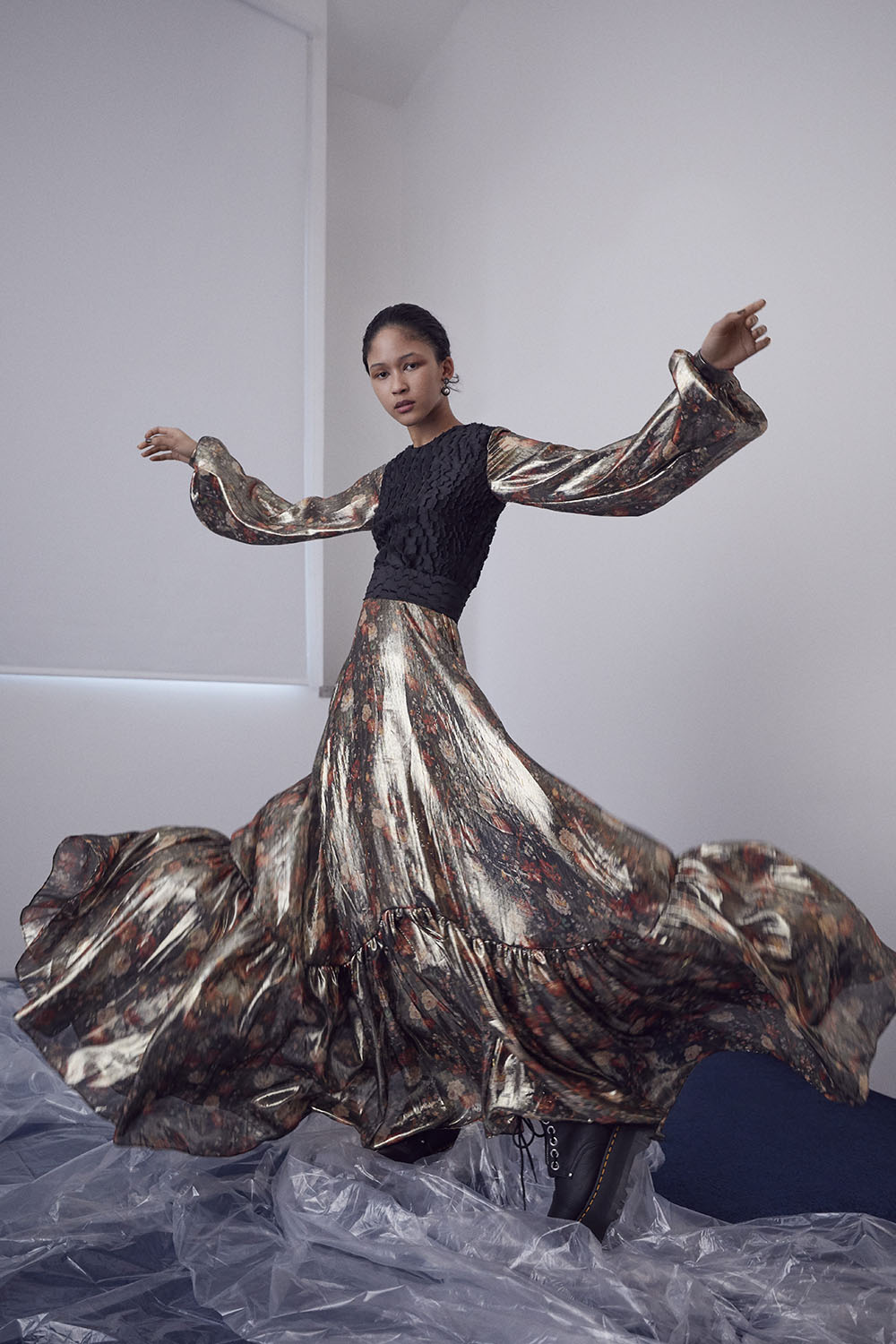
Fashion /
“We were starting to question the fashion system’s rigidness over seasonality,” explains Teatum over Zoom. “When you look at the face value of a material, it’s crazy to think that the value of that material is attached to a six month window, and once it’s outside of that window, you don’t like it anymore. It’s bonkers.” Until then, the pair had succumbed to the industry’s fervent demand for constant newness. They’d develop a range of new fabrics each season, many of which would never make it to the show or shop floor. “We’d have rolls of fabrics that we spent weeks developing and they were beautiful, but for whatever reason they weren’t right for the runway,” says Teatum. “We kept it all, but it was becoming a problem where we had these beautiful things, they’re just hiding away, but we’re creating new stuff,” agrees Jones. “When you start to open your eyes to what you have, you think: these are as beautiful as the other pieces, they just need a moment.”
Their second ReLove collection is made using 12 of Liberty’s deadstock archive fabrics that were deemed imperfect, and donations of unsold denim from Save The Children. These were fused with the brand’s own unused textiles to recreate a selection of Teatum Jones’ best-selling styles. But why not design a new collection around these fabrics? “We have an ethos: don’t throw away good design,” says Teatum. “For the first few years, we went hell for leather on designing collections because we were new and we fell prey to the buyers who were asking: what about newness? But we got to the point where we thought, this dress is amazing, it’s been amazing for the last four seasons. Why are we not working with it further?”
The brand has always taken inspiration from human stories, so it was an emotional connection to the communities they researched that pushed the brand to go seasonless. “We put a lot of development into our collections – one collection we looked into disability and we were getting to know a community, then suddenly February was around the corner and fashion week was telling you to put it on the catwalk and say goodbye to it,” says Jones.
Now, the brand drops collections that sit within a wider, ongoing exploration of a theme. “It’s about paying homage to the subjects we’re researching, but also doing the same thing to materials that come from that research,” says Teatum. “Because so much goes into developing the collections, there’s lots of emotional narrative that’s wrapped up in the design process, so we were paying respect to all of that.”
Slowing down their business and developing the ReLove initiative has also revived the team’s passion for the craft, says Jones. “It’s taken us back to our love of why we joined fashion when we first started,” he says. “Even compared to our college days, we’re much more hands on – we’re pulling out these fabrics, quilting and patchworking. It’s exciting, finding that love again. We’ve had the space and time to really focus on fashion as opposed to the treadmill [of the industry].”
Working solely with unused or unwanted textiles hasn’t been without obstacles, but the duo have never been ones to shy away from a challenge. “I think it forces you to be more creative,” says Teatum. “But it depends which way you look at it and what kind of person you are. You can look at it as [creatively] limiting, because there are limitations to dealing with small lengths of fabric and what you can do with them. Or you’re people like us who think: how can we make this even better than it was four seasons ago?”
If ever a brand could have been ready for the pandemic, it was Teatum Jones. Having already stepped back from the system, slowed production down and focused on seasonless design, their model was one that other brands were forced to adopt when COVID hit. “Everything shifted, and suddenly the idea of ‘we can’t change this system, it’s too big’ had to change,” says Jones. “There are designers who have been talking about what needed to change, but the pandemic forced everyone to stop and think about how we can do it in a better way. We thought it could be done before it was forced to, now I just hope the changes carry on and we push through with them instead of falling back into old thinking.”
As many brands grapple with how to rework unsold stock and design around the rolls of unused textiles sitting in their warehouses, Teatum and Jones hope that ReLove can act as a use case to prove that beautiful clothing can come from old or unwanted textiles. The key to success, they believe, is in collaboration. “When you partner with other brands, you introduce scalability, which is the one question that keeps getting thrown at us,” says Teatum. “It’s one way of answering that question, by bringing in partners like Liberty and Save the Children. You can do this on an industry-wide level, but it’s about partnering with multiple players who can bring awareness to the initiative.”
As for the future of the ReLove initiative, the pair are already in conversation with new collaborators to continue expanding their impact through creatively transforming waste textiles into timeless handcrafted collections. “ReLove depends on partnering with people who have the same belief in the concept, who can authentically work with us to create something beautiful that will sell,” says Teatum. “The more people you work with, the louder it gets, and the more that other designers and retailers realise that it’s possible.”